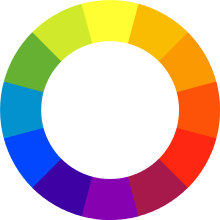So, now you know your primary, secondary, and tertiary colors.
Now, it gets good.
Complementary Colors
Oooooh yeah.
This is why the color wheel is not arbitrary. Other than the fact that every color leads to another and it shows you which colors make the other colors, but whatev.
Here’s that color wheel again:
Say you love yellow. You love it more than any color. I don’t love yellow, but you do. You want yellow to pop out of your painting and shine like it has never shown before.
You have a couple options for this, but they all involve its complementary color. So where is that? It’s directly opposite yellow on the color wheel. Violet. If you put yellow and violet right next to each other, they create tension. Your eyes won’t know where to look so they “vibrate” between the two.
I know, you probably don’t want your eyes to vibrate, or maybe you do, that’s okay too, but let’s say you don’t. You really just want this yellow to stand out. You’d use more violet. The more violet you use around the yellow the more your eye will have to look at the yellow. It won’t have a choice.
That’s not really mixing paint though, it’s just laying it side by side or around the yellow. If your yellow is too bright, standing out too much, you can gray it out with a bit of violet added to the paint and vice versa.
This is actually how you would get a completely neutral color. Mixing equal parts of each complementary color. If you wanted a black, you could mix all three primaries. More on this later.
This painting, which I did a few years ago, is a great example of complementary color scheme:
I have blue in there, but as you can see, the painting is mostly shades of green with just a pop of red to draw your eye to the focal point.
My favorite complementary colors are orange and blue. Then yellow and violet, and finally red and green. If you have a favorite, let me know in the comments.
Want more? Here’s part 1 or check out the books below. Purchasing them from this link supports my site.
Affiliate Link:


